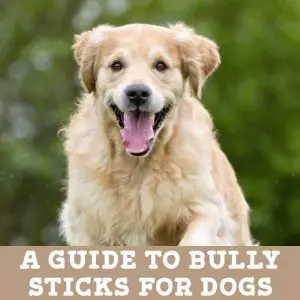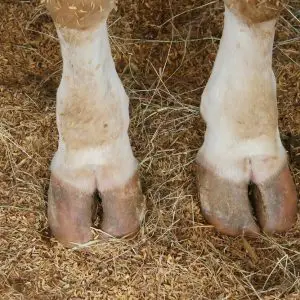
Bully sticks for dogs seem to be all the rage, but did you know what they really are? Beef or steer pizzle (penis)! So many people have no idea, and while it might be something that grosses you out, your dog certainly won’t complain. So maybe you’re thinking, why would you want to buy something like this? What are the benefits for your dog? And are there any risks?
In this article, we will explore both the benefits and the controversies of this unusual treat, so you can make an informed decision whether it’s a good choice for your dog.
Key facts
The pro’s & con’s of bully sticks
Bully sticks (also known as pizzle sticks, or bull pizzles) are made of bull penises
They are a tough chew — excellent for oral health and releasing endorphins
They are high in calories so you should only feed one or two a week max
Bully sticks can carry harmful bacteria including salmonella — reduce the risk by buying from reliable sources and always wash your hands after handling
Bully sticks stink! Great for dogs but not necessarily great for owners
They are highly digestible, meaning the risk of intestinal blockage is low
If large chunks are bitten off this can create a choking hazard — reduce the risk by supervising your dog and removing the final piece
It’s OK to give them to puppies (but only for 5-10 minutes at a time)
What are Bully Sticks?
Bully sticks are made from beef or steer penis which has been stretched and twisted, before being dried. The drying process is usually through dehydration, however sometimes they are baked or smoked instead.
Some will also have been treated with chemicals or irradiated to kill off harmful bacteria.
Once fully dry, they are cut into 6-, 12- or 30-inch pieces and packaged, ready to feed your dog as a treat.
Benefits of Bully Sticks for Dogs
Key benefits
Dental Health
Bully sticks remove tartar, reduce bacteria on teeth and promote strong jaw muscles. They can provide hours of chew time.
Mental Health
As with any long lasting chew, bully sticks stimulate a release of endorphins, promoting good mental health.
Oral Health Benefits of Bull Pizzles
One of the main benefits that attract pet parents to bully sticks are the oral health benefits. Bully sticks are pretty tough, and will give even strong chewing dogs a good 30 minutes of chewing time. Smaller dogs may even get a few hours or days out of a bully stick. All that chewing is great for teeth, due to the mechanical abrasion which helps remove tartar.
Mental Health Benefits of Pizzle Sticks
In addition to that, chewing and licking stimulates a release of endorphins, which reduce anxiety and provide loads of mental stimulation. So if you have a dog with phobias or separation anxiety, bully sticks (or any long lasting chew for that matter) could help them.
Nutritional Information for Bully Sticks
Nutrients & Compounds
Bully sticks are pretty nutritious. They are primarily made up of protein (around 80-90%, and are low in fat (approximately 3%) and low in cholesterol.
Calories
Don’t Overfeed
Bully sticks are extremely high in calories. The mean caloric density of a bully stick is 15 kcal/inch, which means a small, 6-inch bully stick is approximately 90 calories! To put that into perspective, that could be anywhere between nine and 30 percent of the daily calorie requirement for a dog, depending on the size. That’s a lot for a treat.
Feeding Guide
Pizzles should only be given as part of a balanced diet. And since they make up a large percentage of daily calories, are not suitable as a daily treat. You might therefore wish to just give bully sticks on special occasions, or alternatively give a maximum of one or two a week. But remember, those calories need to be taken from somewhere, so on the days your dog gets a bully stick, give him less food in his bowl.
Are Bully Sticks Safe for Dogs?
Safety Information
The main risk associated with bully sticks for dogs are from bacterial contamination. Try to source bully sticks from reputable companies with safe manufacturing processes. And always wash you hands after handling them.
Bacterial contamination
Dogs have much stronger stomach than humans, and can tolerate bacterial contamination to some degree. However, sometimes it can cause stomach upsets, and symptoms such as vomiting and diarrhoea. This can be avoided by buying bully sticks from reputable companies, who put them through some form of processing and manufacture dog treats in a hygienic establishment.
As well as being highly calorific, bully sticks have gained some bad press for being contaminated with bacteria. Naturally, any product which is ‘all-natural’ will have had minimal processing, which means harmful bacteria can still remain on it. The more processed it is (for example, irradiation, baking at a high heat, or using chemicals to sanitise it), the safer it is from contamination. But those processes take away from the fact that one of the most common reasons why people like bully sticks is that they are natural.
So if you’re going to be giving your dog bully sticks, remember to wash your hands afterwards, and sanitise where they ate, as these bacteria can cause serious illness in young, old and immune-compromised individuals.
2018: A Major recall
Did yOu know?
In 2018, the FDA announced a major recall of thousands of bully sticks due to contamination with Salmonella. But Salmonella is not the only bacteria which has been associated with bully sticks in the past. A study in 2013 showed out of 26 bully sticks, three were contaminated, each with a different type of bacteria; Clostridium difficile, Staphylococcus aureus (MRSA), and Escherichia coli. Those are some dangerous pathogens!
Choking
When a pizzle stick becomes small enough to swallow whole, it becomes a hazard. If it reaches the stomach, it shouldn’t cause a problem, as they are fully digestible. However, prior to the stomach it can become lodged in the throat, which can cause serious choking incidents. Therefore, when it becomes small, take the last bit away.
Beef Allergies
Bully sticks are made up mainly of protein, so if your dog suffers with beef allergies, it will certainly cause adverse effects.
Avoid If…
In addition to these risks, since bully sticks are very high in calories, they should not be given to dogs who are overweight.
Are Bully Sticks Unpleasant to Have in the House?
Most bully sticks for dogs stink! The very natural, unprocessed ones have an extremely strong odour to them, and you will most certainly want your dog to eat it outside only. However, some bully stick producers claim they have no odour. These ones will have been more processed, and once chewed will still smell, although to a lesser degree. However, they will be significantly more tolerable than the most natural ones.
Bully Sticks for Puppies

Limit Chew Time
Dogs of any age can chew bully sticks. They are hard, but not so hard that they will damage puppy teeth. Therefore they are great for your puppy to gnaw out his teething frustrations on.
However, puppies have a more sensitive stomach than adults, and therefore you should take away the bully stick after five to 10 minutes of chew time.
Alternatives to Bully Sticks
Thinking about buying your dog bully sticks, but not fully sold on the idea? Here are some alternatives which you might want to think about:
Deer antlers: These are great for chewing on to improve dental health, relieve boredom and reduce anxiety. Since they aren’t ingested, they are a wonderful fat-free option to bully sticks.
Ostrich tendons: If you’re looking for a consumable chew, ostrich tendons are long in size, like bully sticks, and help improve dental health. They last a similar amount of time as bully sticks, and are also packed full of protein.
Raw Meaty Bones (RMBs): A study at Rutgers University showed that raw meaty bones reduced oral bacteria by 79%, which is excellent compared to the respectable 60.2% which bully sticks reduced bacteria. Therefore will significantly improve your dog’s dental health. Bones pose a risk of intestinal damage and obstructions though. This risk is less if they are raw, but still there is a risk.
Yakers: Originally from the Himalayas, these milk sticks are compressed blocks of yak milk which have been smoke-dried for about a month. They are completely natural, incredibly durable and excellent for dental health. Nevertheless, much like bully sticks, they are not suitable for overweight dogs due to their fat content
FAQs
Dogs certainly can develop diarrhoea from bully sticks, due to their richness, or due to bacterial contamination. In most instances, this will clear up with a few days of bland food. However if your dog feels unwell, or it doesn’t improve, you should seek advice from your vet.
Nevertheless, most dogs will tolerate bully sticks with no adverse effects at all.
Bully sticks are highly digestible, so the risk of intestinal blockage is very low. This is because bully sticks are broken down in the stomach relatively easily. However, if large pieces are swallowed, they can cause an obstruction in the throat, and cause your dog to choke. So, remember to supervise your dog, and take away the last bit before it’s consumed.
Bully sticks are beef by-products. They are harvested from the beef meat industry so that very few parts of the carcass are wasted. Cows can be farmed all over the world, with varying levels of animal welfare. Therefore, it is best to buy locally-produced, organic bully sticks.
Bully sticks certainly can be good for dogs but this isn’t a black and white issue. Bully sticks are tough, long-lasting chews that are great for oral health but they are high in calories and can be contaminated with bacteria. This article goes into some depth about the benefits and risks…
Yes! Puppies can have bully sticks (pizzle sticks)! They are reasonably soft and so don’t present a risk of harming their puppy teeth. However, you should only feed for 5-10 minutes at a time to avoid upsetting their sensitive tummies.
Bully sticks, also known as pizzle sticks, are made of dried bull penises. They are dehydrated and cut into 6″, 12″ or even 30″ pieces.
You should take a bully stick away once it becomes small enough to swallow because small pieces of bully stick become a choking hazard. For puppies you should take a bully stick away after 5-10 minutes.
A dog can have 1-2 bully sticks a week if they also have a normal, balanced diet. Pizzle sticks are very high in calories so they are ideally given as an occasional treat. And their normal food should always be reduced on days they are fed a bully stick.
Bully sticks can last anywhere from a few minutes to an hour or so depending on the size of your dog, how big a chewer they are and the size of the bully stick. Bully sticks are semi-soft chews and some dogs will wolf them down in a couple of minutes whereas puppies will take much longer.
Yes, dogs can choke on bully sticks. This is most likely to happen once a bully stick has been chewed down to a swallow-able size. So it is a good idea to supervise feeding and remove a bully stick at this point (especially if your dog is a gulper).
There is no difference between pizzle sticks and bully sticks. They are just different names for dehydrated bull penises. (Read this article for much more info!)
There are loads of calories in bully sticks! Expect around 15 kcal per inch. That means that even a small bully stick can be nearly 100 calories! It’s important not to overfeed and to reduce their normal feed whenever you treat with a pizzle stick.









